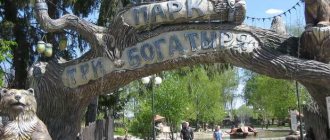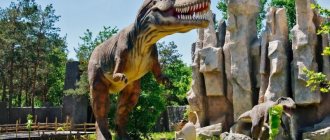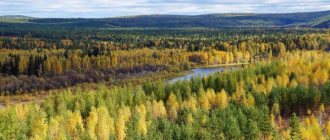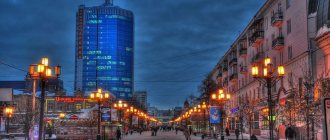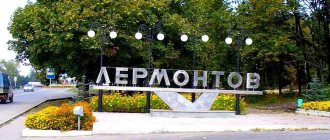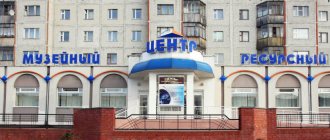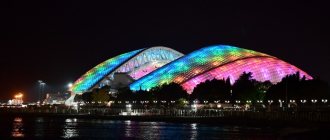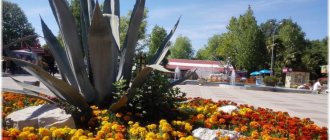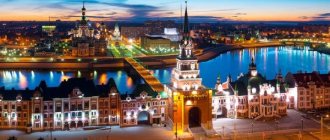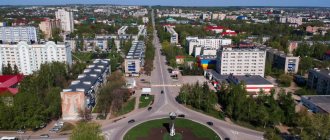Valdai is a treasure trove of natural and historical attractions. This is a land of stunning mountains and unique lakes, water streams full of fish, and rich fresh air. The city itself in the Novgorod region is one of the oldest in Russia and dates back about five centuries, according to historians. This is a place of bells and lakes, natural areas and mountain rivers. Tourists are attracted by the various attractions of Valdai. Some of them are not so famous, but that does not prevent them from being unique and amazing.
History of the national park
Valdai National Park was organized in 1990. The first Valdai Nature Reserve appeared in the early 20s of the 20th century, but ceased activity during the Great Patriotic War; until the end of the 1980s, the territory was occupied by army units with rocket launchers.
In the 1990s, the park actively established contacts with Russian and foreign environmental organizations, published books, brochures and video materials, and held scientific conferences.
The next 10 years are rich in events - the park entered the UNESCO world network of natural reserves, archaeological research is being carried out, guidebooks with tourist routes are being published, the memorial sign “Ignac Cross” is installed, scientific conferences are held, articles and books are published about the nature of Valdai.
In 2011, a visitor center was opened in the city of Valdai with an exhibition dedicated to the park. Cooperation with scientists and teachers continues, international symposiums are organized, and volunteers take part in the activities of forest districts.
A fire station was opened in 2013, and federal exercises to practice actions in case of forest fires took place in 2014. In the future, guest houses, tent sites, ecological trails will be built on the territory, and information stands will be installed.
Geographical features and characteristics of the park
The climate of Valdai Park corresponds to a moderate continental one with a small temperature range in summer and winter. In January, thermometer readings rarely fall below -15°C; in June they do not rise above +25°C.
Summer precipitation in the form of rain predominates, snow cover lasts about 4.5 months, its height is 40-45 cm. A characteristic feature of the Valdai climate is rapid weather changes during the day; long periods of stable characteristics are rare.
Most of the park's territory is occupied by forests (86%). The flora is represented mainly by coniferous (about 45% of the area) and mixed (almost 52%) forests, with oak forests found in small areas. Representatives of forest vegetation: pine, spruce, birch, and in some places aspen and gray alder.
The swamps are dominated by green moss and sphagnum; pine, birch, and sometimes spruce and black alder grow everywhere. Treeless swamps are rare. Plants of the lower tier are common in forests in the middle zone. In river creeks and lakes you can often see yellow egg capsules and snow-white water lilies.
Faunal diversity is explained by the widespread development of forests and a fairly mild climate. Common species of large animals are moose, brown bears, wild boars; predators are represented by wolves, foxes, raccoon dogs, badgers; lynx, otter, and ferret are rarely seen. Among small mammals, the hare, beaver, marten, mink, ermine, squirrel, and mice are observed everywhere.
Among birds there are many “transit” species that appear during migration or in winter. Woodpeckers, tits, herons, and black grouse are permanent residents. The black stork and predators (peregrine falcon, golden eagle and others) are included in the Red Book of Russia. The rivers and lakes are inhabited by pike, whitefish, catfish, pike perch, and sometimes grayling and trout.
The natural conditions of Valdai are unique - with moderate precipitation, a situation of high humidity has developed here, thanks to the large number of rivers, lakes and swamps. Smooth hills do not create dangerous phenomena such as landslides. Spring floods are not catastrophic, although they flood vast areas.
Rivers have winding channels, steep banks, and a sandy, clean bottom. Lakes have indented coastlines and often have bizarre shapes. Small forest lakes are shallow - 3-5 m, one of the large Valdai lakes is 52 m. Mineral springs and healing mud are found on the territory.
Glacial landscapes are observed within the park. Hills of various shapes, chains of hills give way to flat lowlands, basins with small lakes. Characterized by flat-topped hills on which swamps develop. Some of them give rise to streams and rivers.
Attractions
Valdai National Park is known for its amazing nature; lovers of historical tourism and pilgrims are attracted by its attractions.
Iversky Monastery
The construction of the monastery on Selvitsky Island in the middle of the 17th century was initiated by Patriarch Nikon, following the model of the Athos monastery of the same name. In 1655 the first inhabitants appeared. The territory was enclosed by stone walls with several towers.
Inside there were 2 cathedrals, 3 churches, chapels, a bell tower, fraternal buildings with cells, hospital buildings and for guests. The Church of the Assumption of the Virgin Mary was larger in size than many churches in Russia at that time.
Until 1917, the monastery had times of prosperity and decline, persecution and revival; soon after the revolution it was closed, the property was transferred to the state. Subsequently, the premises were occupied by museums (historical, archival and local history), workshops, a hospital, a home for the disabled, and a forest school. In the second half of the 20th century, a village was built on the island, and a recreation center was located in the monastery premises.
In 1991, the monastery was transferred to the jurisdiction of the Novgorod diocese. The restoration of all buildings begins with the strengthening of the foundations, the residential village is resettled in the city, electricity, heating, gas are installed, and a modern road is being built.
Bells were donated to the bell tower, iconostases were installed, and reliquaries were made for the relics of saints. In the Nikon Tower there is a museum of the history of the monastery and an exhibition dedicated to Patriarch Nikon. At the end of the 2000s, all domes were gold-plated for the first time.
A bus runs to the monastery from Valdai on Sundays, you can get there by taxi, or walk. Upon application, pilgrims are accepted and accommodated in the monastery hotel.
Don't miss the most popular article in the section: Metro Nizhny Novgorod. Diagram, map, description.
Ignac Cross
The memorial cross was erected in 2003 at the suggestion of the national park workers in the woods of the same name. A boulder is mounted into a concrete slab, with a 2.3 m high cross with Orthodox symbols attached to it. At the base there is a cast iron board with an inscription.
According to information from the chronicles, it was precisely this place that the Horde warriors reached in 1238 and turned back without attempting to take Novgorod and Pskov. It is still unclear to scientists why this happened, but the approximate location of the Ignach Krest tract on the banks of the Polomet River has been established.
The memorial sign was consecrated by the Archbishop of Veliky Novgorod in honor of the courage and steadfastness of Russian soldiers who died for their faith and Motherland in fierce battles.
Nikolsky fish hatchery named after V. P. Vrassky
This is the first plant in Russia engaged in breeding fish from caviar to market size. Founded in the village of Nikolskoye in 1860 by V.P. Vrassky, who achieved success in developing methods for growing and transporting fish, preserving fertilized eggs, and created a system of ponds. The results of his research are used by modern aquaculture specialists.
The plant operated successfully before the revolution, then continued operations until the Great Patriotic War. In the first months of the war, all objects on the territory were destroyed. The revival began at the end of 1945, and by the beginning of the 50s its activities were restored in full.
Currently, the plant has 54 ponds, breeds pike, crucian carp, and carp, and stocks the reservoirs of the Novgorod region with valuable commercial species. There is a museum at the plant, and excursions around the territory are offered.
Recreation and services in the park
The national park offers recreation and excursion services in the Valdai expanses. All issues related to tourism activities are resolved at the main office or in the forestry departments.
- From 2021, to visit the park you need to issue a ticket and make a one-time payment of 100 rubles. regardless of the time spent on the territory. An exception to the rule is local residents and their relatives, children under 7 years old, volunteers and several other categories who do not pay for their stay. There is also a discounted rate of 50 rubles.
- For recreation, park workers have built wooden houses on the shores of lakes. In the village of Polnovo, located on Lake Seliger, there is a house for 4-6 people, 3000 rubles per day for the whole house. In the village of Nikolskoye (Lake Velye) there are 6 houses for receiving guests of varying capacity (3 - 10 people) and cost (from 600 to 1700 rubles / day for each person). All houses are equipped with modern amenities, there are slopes to the water, places for barbecue and fire pits, garbage containers, and parking. To travel to the houses, you can arrange a transfer from Valdai.
- Those wishing to stay in the city can book rooms at the visitor center hotel, where guests are accommodated in 24 rooms. Accommodation in economy class rooms costs from 500 to 1000 rubles/day, in standard class from 1300 to 2000 rubles/day. In summer and on New Year's holidays, all figures increase by 100 - 400 rubles. Economy rooms have a toilet and shower on the floor. Check-in and check-out time is 12:00. There are preferential rates with a discount of 10 – 50%. It offers 2 conference and meeting rooms, a tea room, barbecue facilities, billiards, tennis tables, bicycle rental, and parking. The hotel temporarily does not accept visitors during the winter months due to renovations, but is welcoming guests from March 1, 2021.
- Fans of camping are provided with special sites (80 parking lots), equipped with the necessary set of forest furniture, there are toilets, fire pits, garbage containers, information stands, and parking. Price 100 rubles/day for each vacationer, for children 7 - 14 years old 50%.
- The park has developed routes for walking and bus excursions. There are 4 ecological trails of varying lengths throughout the park. For preschoolers and elementary school students, an entertaining and educational tour “Pathfinder” is offered around the visitor center and the surrounding area.
- An additional opportunity for active recreation is an extreme route from the village of Nikolskoye on ATVs outside the park to the swamps; duration 2 days. The cost of the tour is 24,000 rubles per person, which includes equipment rental, instructor services, fuel, equipment, and food.
The location of Valdai Park on highways and railways makes it accessible to visitors, especially in summer. Therefore, rooms in hotels and guest houses should be booked in advance.
What tourists say
Guests of the national park from different parts of the country speak positively about their vacation in the Valdai National Park. Tourists note that the route is comfortable to travel with small children; you don’t have to look for a parking lot for a long time.
| pros | Minuses |
| Diversity of nature | Lack of organized transport from the beginning and end of the route |
| Equipped parking lots, camping areas | Two springs along the entire route |
| Emergency exits from the trail every 10 kilometers | It happens that there is no firewood in the parking lots, so take a burner |
| Buying a ticket online | Full autonomy without the ability to replenish supplies |
| Route navigation: every kilometer of the route is marked | Partial cellular coverage |
| Interactive thematic stands with QR codes about the inhabitants of forests, lakes and rivers | |
| Easy difficulty |
Trekking along the Valdai Trail is universal, it is suitable for both experienced hikers and people who have no experience in covering such routes.
The end of the trail is just as unsightly as the start.
Lakes and a lookout adorned this route.
Tourist significance of the park
Valdai National Park attracts not only tourists on its territory; frequent visitors include students from surrounding schools, environmentalists, biologists, and archaeologists.
Within the park there are archaeological monuments whose age ranges from 5 thousand years to the 15th century. These are uncovered traces of dugouts, mounds, mounds, hills, pits with stone crosses. Historical monuments include numerous dilapidated noble estates of the late 18th – 19th centuries. In some places, buildings or their fragments and traces of landscape parks have been preserved.
At first, after the creation of the park, tourism was spontaneous; a system for registering and organizing visitors was gradually developed and implemented. Today, various types of tourism have been developed - from educational to religious and extreme.
The staff includes 5 specialists in tourism and environmental education, and 4 researchers are constantly working. The park hosts annual Biankov Readings, clean-up campaigns on the shores of lakes and forests, and cleans up ecological trails.
Schoolchildren, the public and volunteers provide great assistance in this regard. Excursions around the visitor center museum are regularly organized for students of different ages. The park hosts celebrations and meetings with interesting people.
Currently, employees of various educational and research institutes of Russia are conducting research in the park, and students of universities of the relevant field are also undergoing internships.
Valday Ultra Trail 2021
On August 15, 2021, trail running took place along the Valdai Trail at a distance of 105 km, 55 km, 30 km, 15 km, 5 km and a children's race. People of all ages and with different physical fitness took part. The winners of the longest distance among men and women were Petr Sedov and Evgenia Kretova.
The route was laid through local attractions - the suspension bridge over Polomet, the Ryzhokha observation tower and the beaver dam. It is expected that such a race will be held annually during the summer months.
Prices in the national park
To participate in excursions, you do not have to live on the territory, but to visit the park you need to issue a ticket and make a one-time payment in addition to the cost of the excursion.
| Walking excursions | ||
| Name | Duration, hour | Price up to 10 people/more than 10 (RUB/person) |
| From Seliger to Borovno | 1 | 150/100 |
| By visitor center | 1 | 80 |
| The city streets tell a story | 1,5-2 | 200/100 |
The cost of bus excursions does not include meals, even if a visit to a cafe is included in the program.
| Bus excursions | ||
| Name | Duration, hour | Price up to 10 people/more than 10 (RUB/person) |
| Valdai springs | 1,5-2 | 200/100 |
| Mshenskie springs | 3-3,5 | 250/150 |
| Valdai-Iversky Monastery | 1 (by monastery) | 250/150 |
To hike along the ecological trail you need to have comfortable shoes, a raincoat, and repellent.
| Ecological trails | Duration, hour | Price up to 10 people/more than 10 (RUB/person) |
| Beaver | 1,5 | 200/100 |
| Forest secrets | 1,5 | 200/100 |
| Sokolovskaya | 1 | 150/100 |
| Ivan's copses | 1,5 | 200/100 |
| Pathfinder | 40 minutes | — |
At the visitor center you can buy souvenirs and printed materials dedicated to the national park.
Travel budget
| Service | Price |
| "Swallow", St. Petersburg - Veliky Novgorod | 614 rubles |
| "BlaBlaCar", Veliky Novgorod - Valdai | 250 rubles |
| Entrance fee to the national park | 200 rubles |
| Parking in an equipped camp | — |
| Suburban bus, Staraya Russa - Veliky Novgorod | 250 rubles |
| "Swallow", Veliky Novgorod - St. Petersburg | 580 rubles |
| Groceries for a hike, snacks at the station and other expenses | ~ 1000 rubles |
| SPENT: 2894 rubles |
Hotels nearby
Valdai National Park has its own hotel in the visitor center. Tourists can use other hotels located in the city area and explore the sights on their own.
- Complex "Valdai Dawns" located near Solovyovsky Park on the shores of Lake Valdai. Modern comfortable rooms with a minibar, heating, a restaurant, its own equipped beach, free Wi-Fi, parking - everything is at the disposal of clients. There is a conference room. Meals (buffet) are included in the total price.
For sports enthusiasts, rental of skis, bicycles, boats, catamarans, fishing. Pets are paid separately. A transfer to the Valdai railway station and the Iversky Monastery is possible.
Address: st. Molotkovskaya, 2. Price depending on capacity and time from 1750 to 4400 rubles/day, on holidays it rises to 5400–6600 rubles/day for 1 person.
- Guest house "Romanovskaya Usadba" is a Russian hut near the city center. The green area, a real bathhouse, and the proximity of the lake create the impression of relaxation in the village. The hotel has a modern level of services, free Wi-Fi, parking, beach. Breakfast is included in the total price; there is an equipped kitchen for self-cooking.
There is a rental point for skis, bicycles, ATVs, and snowmobiles. Fishing and hunting are organized. Pets are paid separately.
Address: st. Belova, 3. Price from 3000 – 4500 to 5500 – 6500 rubles/day for 1 person.
- At the guest house "Cat and Cat" There are non-standard services - warm garages in the building and a gazebo designed for any season. Otherwise, it is no different from other modern hotels with a high level of service located near the lake shore. Rooms for allergy sufferers are available. There is a kitchen for self-catering, tea and coffee are free. On the territory there is a swimming pool, a Russian bathhouse and a special room where chickens and roosters are kept. No payment is required for pets.
Address: st. Pobeda, 40. Free transfer provided. Price 2500 – 3500 rubles/day for 1 person, may increase in summer and on holidays.
- For those who want to not just relax, but improve their health, within the park on the shore of the lake. Dinner at the Valdai holiday home . This is a modern hotel complex with high-class services and the possibility of medical procedures. Located on a peninsula, there is a main six-story building, a mini-hotel, cottages and former government dachas from 1939 (reconstructed in 2010).
Medical care in the spa complex is provided by a therapist, nurses, cosmetologist and specialists in the physiotherapy room. Visitors are offered various types of massage, mud therapy, balneotherapy, and a spa capsule. Fans of active recreation can take advantage of the swimming pool, indoor tennis court, gym and billiards rooms, as well as sports facilities.
Meals (buffet) are included in the total price. In some economy class rooms, meals are paid separately. Smoking and pets are prohibited throughout the property.
Address: Roshchino village, Valdai district, Novgorod region. By arrangement, a bus is available for the night train (free transfer). It is easy to get from Valdai by taxi. The price ranges from 2,000 to 13,200 rubles/day for 1 person, depending on the place of check-in; at dachas in premium rooms it can reach 25,000–30,000 rubles/day for 1 person.
The city has many hotels of different price categories. Most are located on the lake shore.
County town museum
Address: st. Lunacharskogo, 7 Telephone: Opening hours: Mon - day off, other days: 10.00 - 18.00 Ticket price: 30 rubles
One of the eras in the development of Valdai is the time when the local region was a royal district. It is this period that all the museum’s exhibitions are dedicated to. The building is divided into five halls, thanks to which visitors can clearly trace the history of the Valdai region, get acquainted with local crafts, ancient things, and even with the Valdai families who lived in the district during the times of Tsarist Russia.
If you are interested in Russian history of this period, be sure to visit and see the sights of Torzhok and Myshkin.
Environmental and social problems of the park
The territory of the Valdai National Park, in accordance with the law, is divided into several zones, each of which has its own visiting rules. Some of the areas have the status of protected areas , where specialists and scientists of the park can be located.
Volunteers help clear Valdai National Park of garbage
Access to other areas is freer - excursion trails along strictly defined routes and places where tent sites are set up, guest houses are built, fishing is allowed, and parking lots are equipped.
The Valdai region has long been one of the popular tourist destinations. Despite the founding of the park, nothing had changed in the perception of some of the population - vacationers still freely settled along the shores of the lakes, local residents cut down trees, teachers led groups of pupils or students to protected areas.
The park staff managed to rectify the situation, arrange the territory, bring order to the reception of tourists, and attract volunteers. Foresters monitor compliance with the rules established by law.
Cases of guests entering protected areas, attempts at unauthorized hunting and fishing, and lighting fires are still being recorded. Such actions harm the flora and fauna of the park; many of their representatives are listed in the Red Book of Russia or are rare species.
Some visitors leave trash behind; volunteers and inspectors constantly clean the parking areas, although trash containers are installed everywhere.
The park's managers do a lot to promote it and attract tourists. There are tour operators working in collaboration with the park; one of them has an office in the visitor center. It is convenient to use their services when choosing the best place to relax.
The national park invites those who want to relax in nature, immerse themselves in the spiritual atmosphere of the Iversky Monastery, improve their health and simply admire the beauty of the Valdai region.
Article design: Mila Friedan
FAQ
Can wild animals attack tourists?
- The probability that a wild animal will attack is very small, but not zero. You are unlikely to meet a predator, but on the information boards you will learn that these places are inhabited by: moose, hares, foxes, beavers, wild boars, squirrels and other mammals and birds. Be prepared for the fact that at night someone will rustle or flounder in the water next to your tent.
What time of year is best to travel?
- The most popular season is summer. The weather is dry at this time. In autumn and spring there is a high probability of rain and cool nights. If anyone has gone or is planning a hike in winter, then write a review in the comments.
What should you take with you for a hike on the trail?
- It depends on how many days you are going to devote to completing the route. But everyone must have with them: water, food, comfortable change of clothes and shoes, a first aid kit, and be sure to spray against mosquitoes and ticks.
About water separately. What the trail really lacks are springs. From kilometer 11 to ~45 I did not come across a single source of clean water. At about 35 kilometers, in a village near Mount Ryzhokha, I replenished my balance by contacting a local resident. There are no wells in the villages; everyone brings water from the city.
Is it safe for an elderly person to take the route?
- If you have no health problems, yes, but if you are not confident in yourself, it is better not to go on your own and find a travel companion. Tourists do not meet often, and there are interruptions in cellular communications.
Is Internet available on the trail?
- It’s better to forget about fast Internet during your hike. The best place to catch it is the observation tower on Mount Ryzhokha, there is 4G there.

